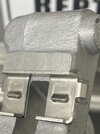Sorry for the late reply.
Thank you for posting some pictures, they tell quite a story.
I see a few things that are damaged, and obvious in your pictures.
First, the spring clip that was in the roof of the caliper has a pretty severe witness mark (wear/damage) on one end, which would suggest that the clip was either dislodged, or bent, or both.
Secondly, the small silver clip that fell out of the bracket, is supposed to be crimped/glued into place at the factory, and this clip should not be able to be removed.
Some folks have attempted to "glue" it back into place, however, I will have to disagree with this method, because the reason it came out in the first place is because the caliper mounting bracket was damaged, and the area where the clip sits is no longer holding the clip in the correct position.
The picture with all the grease on it, shows where you "glued" it back into place on the bracket, however, you can see a GAP between the clip and the bracket, which should NOT be there.
Even with your method of replacing the clip, I would think that the clip can still FLEX and move around under the weight of the stopping force, allowing things to bind up and cause issues.
Your recent picture of the "flutes" inside the hole where the stopper plug sits, points out that the bracket is damaged, and should be replaced.
These spirals, or flutes, could have been caused by many different things, such as the axle nut being tightened BEFORE the stopper plug (which is incorrect), the stopper plug becoming loose and bouncing around, or more commonly, when the SMC failed, and applied all the constant pressure of the rear brakes not being able to release, it damaged your rear caliper bracket (inspect the short arm side) and see if it is worn away, allowing the clip to move and dance around.
It is very common that when the SMC fails, it takes out the rear caliper mounting bracket with it.
Every SMC I've replaced (too many to count anymore) I've had to replace the rear caliper mounting bracket as well.
Another common problem that damages the rear caliper bracket, is folks see the 12mm nut on the guide dowel, and think that it is there to remove this part. This part should never be removed from either the caliper, or the bracket. A couple reasons are because it is a steel part, going into aluminum, and the Factory Service Manual has a typo with the INCORRECT torque value, which can/will damage the assembly when used. I believe Mr. Heath pointed this out in many of his fine articles.
When folks try and torque this bolt to the 50 ft lbs indicated, it sinks into the soft aluminum housing, and tilts things, throwing everything off.
One thing that I do, that is NOT suggested in ANY of the service manuals, is "I" paint the stopper plug with a very light coat of antiseize to slow down the wear on the bracket.
"My" thinking on this is because the plug is steel, and the bracket is aluminum, and by design, these two parts "hit" each other when the brake caliper rocks forward, and rather than a hard steel piece, striking, and digging into the soft aluminum part, "I" think coating it with antiseize, allows it to be more of a "glancing" blow instead of a peening blow if that makes sense.
I've been doing this for many years now, and it seems to slow the damage down, and the rear caliper bracket does not show as much wear when inspected.
Again, this is just what "I" do, and is not suggested anywhere. If you decide to do this, it is at your own risk (disclaimer).
Lastly, I know in your area, with all the crap on the roads, you folks like to cover everything with grease. If you have to do that, (I don't recommend it) I would suggest using as little as possible, so it does not collect dirt and road grime.
I will try and attach a few pictures of what the rear caliper mounting bracket should and should not look like when I get back in the house.














